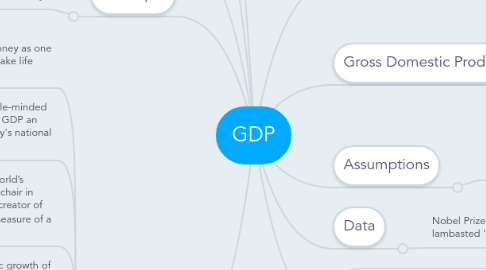GDP
by Petrina Kong

1. Current major economic indicator, widely used by many many countries
2. Gross Domestic Product
2.1. Purpose
2.1.1. Estimate of the total value of goods and services produced in the country; aims to best capture through monetary value of the economy
2.1.2. Defined by the ONS as the sum total of the final output an economy produces
3. Disadvantages
3.1. GDP per capita will not increase if the population increases proportionally with the total output of the country's economic spendings
3.1.1. In the UK, economy has grown but so has the population of the country, leading to little/no increase in the GDP
3.2. Tells us little about our overall/individual economic welfare
4. Perspectives
4.1. Mehreen Khan (The Telegraph)
4.2. Author feels that GDP is not an accurate representation of economic growth of a country and is also not a good measure of economic recovery
4.3. Believes that we should stop fixating on GDP and MOVE ON
5. Assumptions
5.1. NOT MANY - GOOD ARTICLE
6. Inferences
6.1. Other economic indicators should be used along with GDP, to give a more accurate representation of the wellbeing of the individuals in a country, or the economic progress of the nation
7. Concepts
7.1. Economic growth/recovery
8. Data
8.1. Nobel Prize winning economist lambasted 'GDP fetishism'
9. UK economy showed no progress since the Great Recession, when in actual fact the British economy had exited recession 9 months earlier than previously thought
10. Article 2
10.1. Assumptions: People do not see money as one of the more important things that make life worth living.
10.2. Purpose: To show that our single-minded pursuit of GDP growth renders GDP an inaccurate measure of a country's national progress.
10.3. Perspectives: Tim Dean, author of article. Peter Drucker, one of the world’s leading thinkers on business and management. Dr Robert Costanza, chair in Public Policy in ANU (Australian National University). Simon Kuznets, creator of GDP. → what is his perspective? “GDP was never designed to be a measure of a nation’s well-being”
10.4. Question at Issue: GDP solely measures economic growth of a country, and is not an accurate representation of the well-being of the people, and of the state of the environment.
10.5. Implications: Countries may see the negative points of GDP and start using GPI instead as it measures the whole well-being of the people instead of simply from the economic point of view.
10.6. Inferences: GDP is an inaccurate measure of a country's national progress. GPI is a more accurate measure of a country's well-being.
10.7. Data / Evidence: GDP tends to go up after a natural disaster as reconstruction and remediation spur intense activity that is registered by GDP, while the destruction, loss of lives, suffering and disruption to families and communities in the wake of these disasters are ignored. It does not discriminate between beneficial economic activity (new infrastructure, investment in education, etc) and negative activity (cost of crime, pollution, etc)
10.8. While Australia’s GDP has increased nearly three-fold since 1950, GPI has declined since the 1970s, largely due to increasing income inequality, environmental degradation and the loss of social capital. By simply measuring the nation's raw economic activity, GDP does not take into account environmental and social factors, which are vital in determining a country's progress.
10.9. Concepts / Theories: Economic activity is not the sole factor determining a country's progress, and is definitely not a measure of its well-being.



